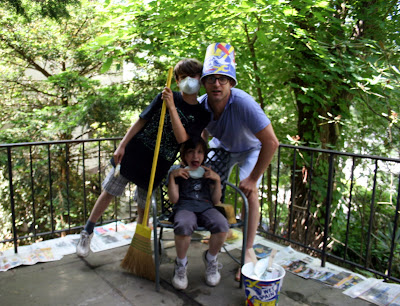
Bryant Park a magnificent oasis which really should not exist. Surrounded by sky-scrapers - in this case, the MetLife and BankAmerica Towers facing east - it offers a blip of calm in an otherwise frantic part of New York rubbing up against Time's Square. Eitan asks if the BankAmerica tower bigger than the Empire State Building but actually it is about half the size or 54 floors. Holy mackerel. On the other side is the library and we are encased by 5th and 6th Avenues and 40th and 42nd Streets for about 9.6 acres. The place has a rich history not surprisingly, and here is what an Internet rake brings forward:
"In 1686 when the area was still a wilderness, New York's colonial governor Thomas Dongan designated this spot a public space. George Washington crossed it while retreating from the Battle of Long Island in 1776. Bryant Park was a potter's feild (a graveyard for the poor) from 1823 to 1840, when thousands of bodies were moved to Ward's Island.
Later on, the square was used for military drills during the Civil War, and was the site of some of the New York Draft Riots in 1863, when the Colored Orphan Asylum at Fifth Avenue and 43rd Street was burned down.
In 1884, Reservoir Square was renamed Bryant Park, to honor the New York Evening Post editor and abolitionist William Cullen Bryant. In 1899, the Reservoir building was removed and construction of the New York Public Library building began.
The construction of the Sixth Avenued Elevated railway in 1878 had cast a literal and metaphorical shadow over the park, and by the 1930s the park had suffered neglect and was considered disreputable. The park was re-designed in 1933-1934 as a Great Depression public works project under Robert Moses. The new park featured the great lawn.
By the 1970s, Bryant Park had been taken over by drug dealers, prostitutes and the homeless. It was nicknamed "Needle Park" by some, due to its brisk heroin trade, and was considered a "no-go zone" by ordinary citizens and visitors. From 1979 to 1983, a coordinated program of amenities, including a bookmarket, a flower market, cafes, landscape improvements, and entertainment activities, was initiated by a parks advocacy group called the Parks Council and immediately brought new life to the park -- an effort continued over the succeeding years by The Bryant Park Restoration Corporation, which had been founded in 1980 by a group of prominent New Yorkers, including members of the Rockefeller family, to improve conditions in the park. In 1988, a privately funded re-design and restoration was begun by the Bryant Park Restoration Corporation and here we are today.
"




















